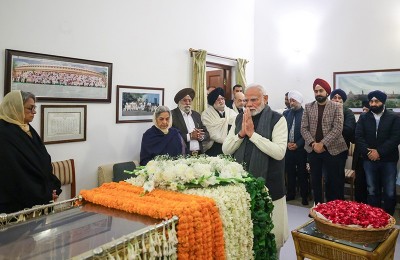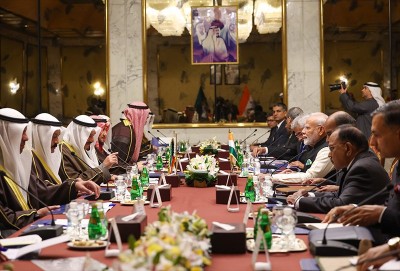
Punjab: Proxies Gone Wild
The last high profile political killing in Punjab was the killing of Salmaan Taseer, the then Governor of the Punjab Province, who was killed in Islamabad, the national capital, on January 4, 2011, by one of his own body guards, Malik Mumtaz Hussain Qadri. Qadri was reportedly incensed by the Governor's efforts to seek a marginal dilution of the controversial blasphemy law [a punitive law against any critic or defamer of the Islamic religion, Prophet Mohammad or the holy Quran] as a result of which conviction under the law would not result in a mandatory death sentence; as also his advocacy for Aasia Bibi, the Christian woman sentenced to death on November 7, 2010, for alleged blasphemy.
Significantly, after assuming the post of Home Minister of the Province on October 13, 2014, Khanzada had reportedly been involved in major operations against domestically oriented terrorists in Punjab, though there was little evidence of any relative improvement of the security environment as a result. According to partial data compiled by the Institute for Conflict Management (ICM), Punjab recorded at least 186 terrorism-linked fatalities , including 129 civilians, 45 terrorists and 12 Security Force (SF) personnel in the 308 days under Home Minister Khanzada, as compared to 109 fatalities, including 69 civilians, 22 terrorists and 18 SF personnel in the corresponding period prior to his assuming office. Indeed, after registering a continuous decline in terrorism-related fatalities since 2011, Punjab had witnessed a sudden spurt in 2014, when at least 180 fatalities were registered, including 132 civilians, 20 SF personnel and 28 terrorists. In the current year, Punjab has already recorded 107 fatalities, including 62 civilians, 38 terrorists and seven SF personnel (data till August 16, 2015).
Khanzada's Ministry recorded its biggest 'success' on July 29, 2015, with the killing of Malik Ishaq 'chief' of Lashkar-e-Jhangvi (LeJ), a terror group which, along with the Tehrik-e-Taliban Pakistan (TTP) remained one of the most lethal domestic extremist formations operating inside Pakistan, though, unlike TTP, LeJ operated essentially as a sectarian outfit, uniquely targeting the non-Sunni Muslim minorities in the country. Ishaq, his two sons Usman and Haq Nawaz, and 11 others, were killed in an alleged exchange of fire with the Police in the Shahwala area of Muzaffargarh District in Punjab. According to reports, Ishaq and his sons, who had been arrested by Counter-Terrorism Department (CTD) personnel on July 25, 2015, were taken by the Police to the area to help them recover weapons and explosives. Police claimed that the exchange of fire took place when Ishaq's supporters allegedly attacked the Police to free Ishaq. Though Ishaq was freed, he was allegedly killed in the subsequent exchange of fire along with the others. It is, however, widely believed that the entire operation was a staged killing.
Meanwhile, a preliminary report submitted to Chief Minister Shahbaz Sharif by IGP Mushtaq Sukhera asserted that Home Minister Khanzada was killed in retaliation to the Malik Ishaq killing. The Ishaq led LeJ, as SAIR had noted earlier, was one of several terrorist formations that had enjoyed the support of the Pakistani establishment over an extended period of time. He was arrested in 1997 and was implicated in dozens of cases, but succeeded in obtaining bail in July 2011, after nearly 14 years in jail. While in jail, he was believed to have masterminded the 2009 attack on the Sri Lankan cricket team in Lahore, which killed eight Pakistanis, though only seven players and an assistant coach of the targeted team suffered minor injuries. He was repeatedly placed under house arrest thereafter, and arrested, again, in 2013, over a series of sectarian attacks. The worst of these was the January 10, 2013, Quetta (Balochistan) bombing, targeting a snooker hall patronized by the Shia Hazara community, in which 92 persons were killed; and another bombing in Quetta on February 16, 2013, which killed 89. LeJ claimed the attacks. Nevertheless, Ishaq again secured bail on March 20, 2014, and was released. His killing in an apparently staged encounter suggests that he had 'crossed the limits' placed on his group by its handlers.
Two terrorist formations have claimed responsibility for the Khanzada killing: TTP-affiliated Lashkar-e-Islam (LI), which principally operates in tribal areas of Pakistan where the Pakistan military has been carrying out massive operation since June 2014, declared that Khanzada's assassination was retaliation for military operations against them. Its 'spokesperson' Saluddin Ayubi added, "Such types of attacks will continue in the future." Further, Ehsanullah Ehsan, 'spokesman' for the Jamaat-ul-Ahrar (JuA), a breakaway faction of TTP, claiming responsibility for the attack Tweeted, "The Attock attack is revenge for the martyrdom of Malik Ishaq shaheed (martyr) and othermujahideen brothers."
Punjab has remained substantially insulated from the high intensities terrorism experienced in Pakistan's other provinces, despite the fact that it is the principal recruiting ground and staging area for a number of state-backed terrorist groups, most prominently including the Lashkar-e-Taiba (LeT) - Jamaat-ud-Dawa (JuD) combine, which has long and openly received state largesse to support its networks in the Province. The degree of freedom and Government support various terrorist formations continue to enjoy in Punjab remains alarming. For instance, the province continues to host massive JuD rallies led by its chief and mastermind of the 26/11 Mumbai attacks, Hafiz Muhammad Saeed, one of the globally most-wanted terrorists. In the latest of such a series, JuD held a rally in Lahore on August 14, 2015, which was also telephonically addressed by Asiya Andrabi, chief of Dukhtaran-e-Millat (DeM), a separatist organization in the Indian State of Jammu and Kashmir (J&K).
According to SATP data compiled till March 2014, there has been a considerable and increasing presence of at least 57 extremist and terrorist groups in Pakistan's Punjab Province. Significantly, on January 14, 2015, Federal Minister of Interior Chaudhry Nisar Ali Khan, during a briefing on the status of the implementation of the National Action Plan (NAP) to counter terrorism and extremism, disclosed that the number of proscribed organisations actively engaged in terrorism and extremism in the Province had reached 95.
Indeed, out of 195 convicts hanged across Pakistan since December 17, 2014, when the moratorium on the death penalty was lifted, 135 were from Punjab alone, though only 15 of these were terrorists. In the latest of such hangings, on July 29, 2015, eight death row prisoners were executed in Punjab. While the spectacle of 'strong action' against terrorism is maintained, preferred groups continue to evade penal action, even as their leaders, such as 26/11 'masterminds' Zia-ur-Rahman Lakhvi and Saeed roam free. Indeed, state apologetics for various 'good terrorist' formations continues, and Khanzada was part of this process of rationalization. Most recently, when at least 15 persons were killed and another 70 were injured in two bomb blasts separately targeting two churches in the Youhanabad Town of Lahore, Khanzada claimed that the terrorists responsible "received Indian directives and funding". Crucially, however, the Minister identified the Shahryar Mehsood Group, which operates for al-Qaeda, and TTP, as responsible for the church bombings, and the affiliations and connections of these groupings are widely known, and do not include any friendly relations with the Indian state or its agencies, to whose destruction they have repeatedly sworn.
Till the time Islamabad continues to differentiate between terror outfits, targeting those only who are domestically oriented while providing all tacit support to those which serves its 'strategic interest', terrorism will thrive on Pakistani soil and terrorists will succeed in eliminating those who will challenge their supremacy.
The Khanzada killing, like the Peshawar Army School massacre, which was also blamed by the Pakistani far right establishment on India, among an interminable succession of other terrorist atrocities, is essentially part of the continuing cycle of blowback and retaliation that has fed domestic terrorism in Pakistan. Ironically, its most prominent victims have been at least part of this cycle, if not as active supporters, certainly in their willingness to look the other way while 'good terrorists' did the state's bidding in the past.
Support Our Journalism
We cannot do without you.. your contribution supports unbiased journalism
IBNS is not driven by any ism- not wokeism, not racism, not skewed secularism, not hyper right-wing or left liberal ideals, nor by any hardline religious beliefs or hyper nationalism. We want to serve you good old objective news, as they are. We do not judge or preach. We let people decide for themselves. We only try to present factual and well-sourced news.







